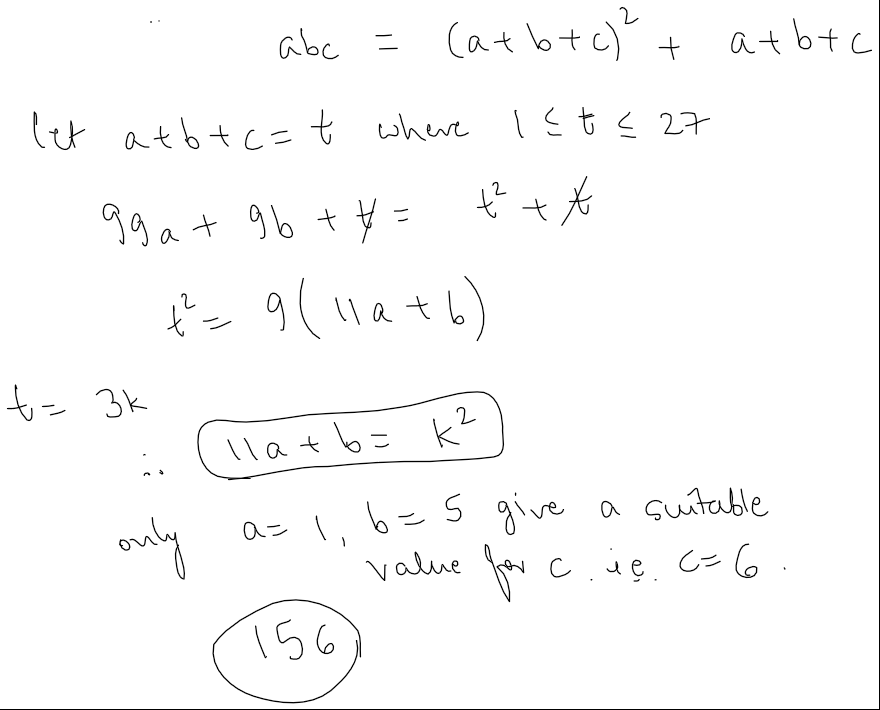Three is a crowd
Find all the three digit numbers a b c such that a b c = ( a + b + c ) 2 + a + b + c . Enter your answer as the sum of all such three digit numbers.
The answer is 156.
This section requires Javascript.
You are seeing this because something didn't load right. We suggest you, (a) try
refreshing the page, (b) enabling javascript if it is disabled on your browser and,
finally, (c)
loading the
non-javascript version of this page
. We're sorry about the hassle.
4 solutions
Did the same way
A simple way to solve problem is :
a + b + c is multiple of 3 , and it is between 3 and 2 7
So that the possible values of
a
+
b
+
c
are 3, 6, 9, 12, 15, 18, 21, 24 and 27
and the corresponding values of
a
b
c
are 12, 42, 90, 156, 240, 342, 462, 600, and 756
And only 1 5 6 verify the equation.
Very nice. This gives us a small list of numbers to check.
Thanks for the solution... This is indeed smaller..
Taking a + b + c common, we have a b c = ( a + b + c ) ( 1 + a + b + c ) which means that a b c is an Oblong number or a number expressible in form of n(n+1). We need to solve for n = a + b + c
All 3 digit oblong numbers are : 110, 132, 156, 182, 210, 240, 272, 306, 342, 380, 420, 462, 506, 552, 600, 650, 702, 756, 812, 870, 930, 992.
As a b c is between ( n ) 2 and ( 1 + n ) 2 , we need to solve ⌊ a b c ⌋ = a + b + c Thus we find squareroot of every number and then see whether its floor is same as its sum of digits.
Doing so, we can see that 156 is the only solution that matches as its squareroot is 12.48999 and sum of digits is 12.

Since a b c has to have three digits, 1 ≤ a ≤ 9 and 0 ≤ b ≤ 9 and 0 ≤ c ≤ 9 .
We can write a b c as 1 0 0 a + 1 0 b + c . Then we can see that 9 9 a + 9 b = ( a + b + c ) 2 and so 9 ( 1 1 a + b ) = ( a + b + c ) 2 or 1 1 a + b = ( 3 a + b + c ) 2
Therefore 1 1 a + b is a perfect square.
But the maximum value of 1 1 a + b is when a = b = 9 when it is equal to 1 0 8 , while its minimum value is 1 1 , when a = 1 and b = 0 . So, overall, we just need to check the cases 1 1 a + b = 1 6 , 2 5 , 3 6 , 4 9 , 6 4 , 8 1 , 1 0 0 , and see if they satisfy the equation.
Let's do this for 1 1 a + b = 4 2 , a + b + c = 4 × 3 = 1 2 .
The only solution to the first equation is a = 1 , b = 5 , which gives us c = 6 .
We verify that 1 5 6 = 1 2 2 + 1 2 , hence this is a valid solution.
Let's do this for 1 1 a + b = 5 2 , a + b + c = 5 × 3 = 1 5 .
The only solution to the first equation is a = 2 , b = 3 , which gives c = 1 0 .
Hence, this is not valid.
We may continue doing so for all the other cases. As it turns out only a b c = 1 5 6 is a valid solution.
Therefore our answer is just 1 5 6 .